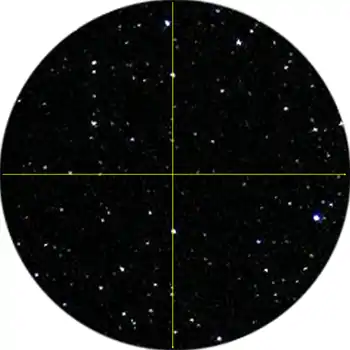Star transit
A star transit is the passage of a star across the field of view of a telescope eyepiece.

Star transits (Reticle 2°, magnif. ~10, two stars passing the vertical thread). Timing accuracy may be ±0,5 s.
The precise observation of star transits is the basis of many methods in astronomy and in geodesy. The measurements can be done in different ways:
- visually (mostly up to 1990): accuracy 0,1" to 2" (depending on the instrument); timing with digital clocks about 0,05–0,2 seconds
- by CCD and other electro-optical sensors: as above, time often better
- semi automatic instruments: Photography or "impersonal micrometer", ca. 2 times better than No.1
- by Scanning methods: Astrometry satellites like Hipparcos about 0,01".
See also
Literature
- Karl Ramsayer, 1969: Geodätische Astronomie, Vol.2a of Handbuch der Vermessungskunde, 900 p., J.B.Metzler-Verlag Stuttgart.
- Ivan I. Mueller, 1969: Spherical and Practical Astronomy as applied to Geodesy, 610 p., Fred.Ungar publ., USA
- IAU Coll.48: Modern Astrometry, Egermann, University Vienna.
This article is issued from Wikipedia. The text is licensed under Creative Commons - Attribution - Sharealike. Additional terms may apply for the media files.